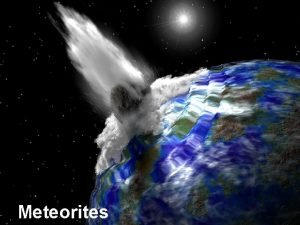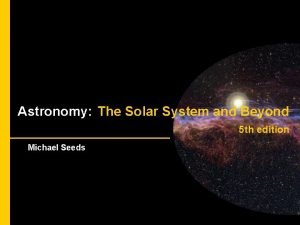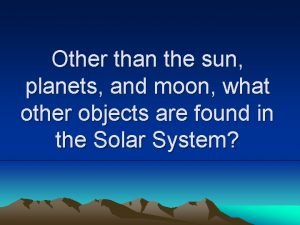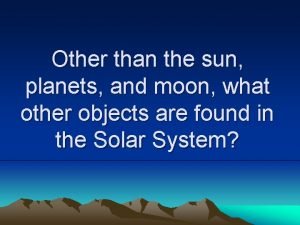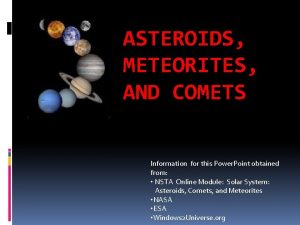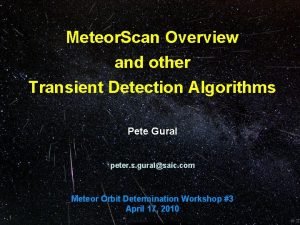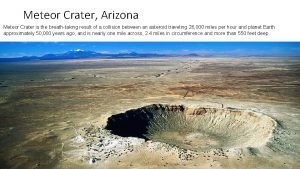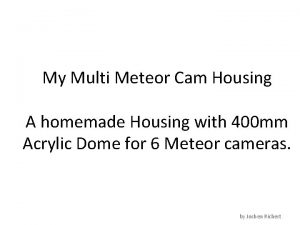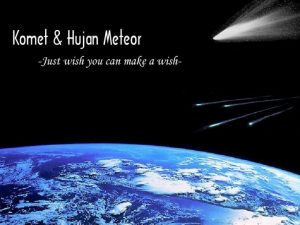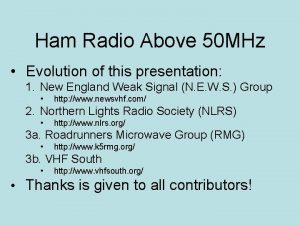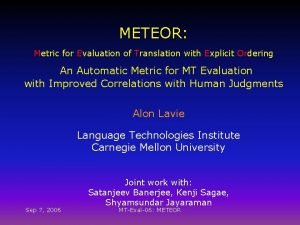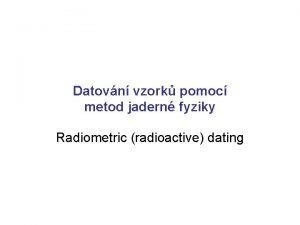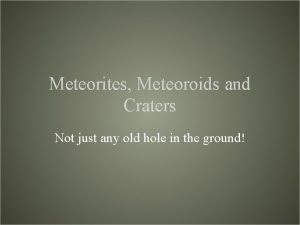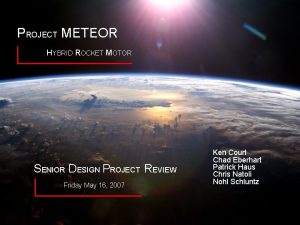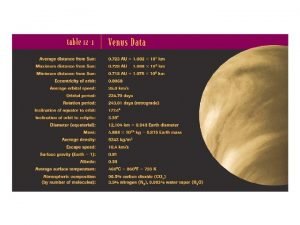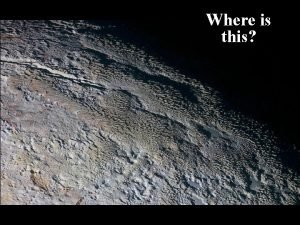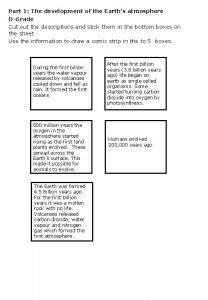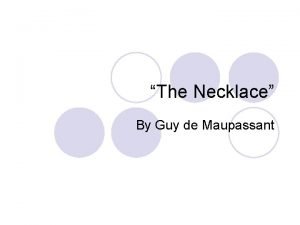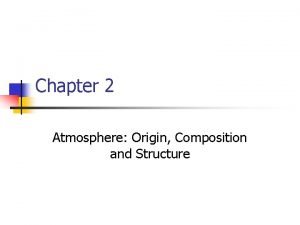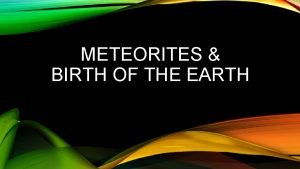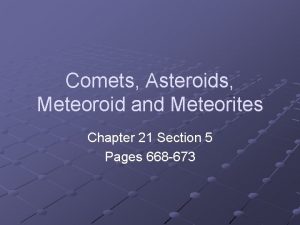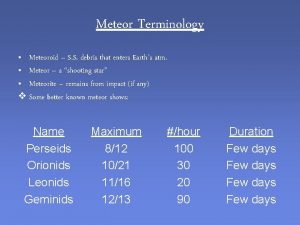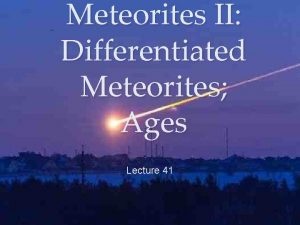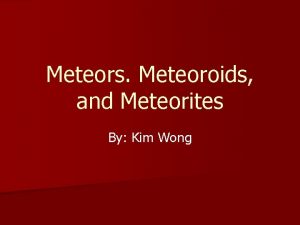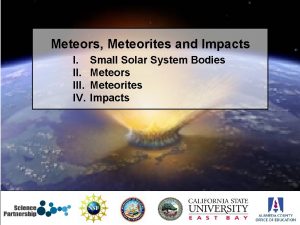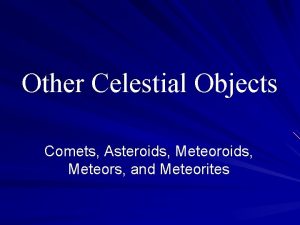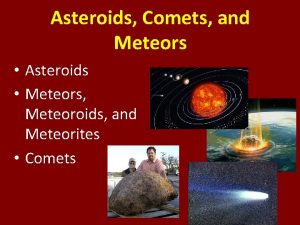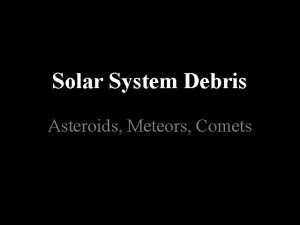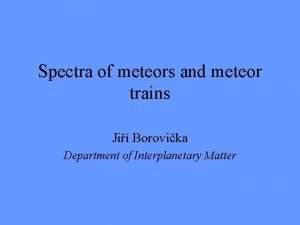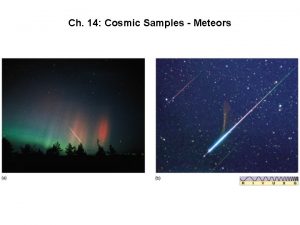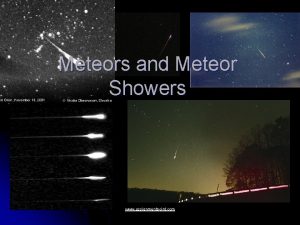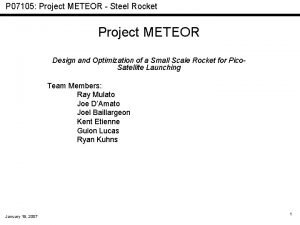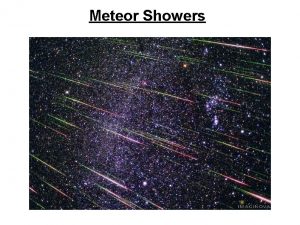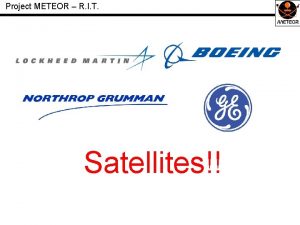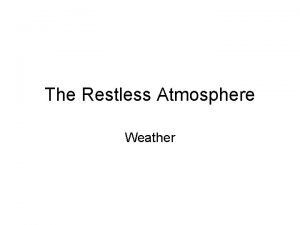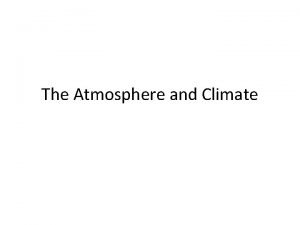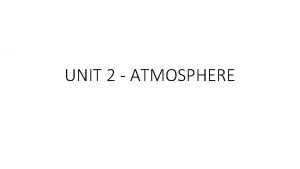Meteorites Meteors Meteoroid in space Meteor in atmosphere


























- Slides: 26

Meteorites

Meteors? Meteoroid in space Meteor in atmosphere Meteorite on Earth

Where do they come from? Asteroid belt: source of meteorites

How do we know? Pribram 1959 Innisfree 1977

Asteroids can be really big • Often smash into each other Mars

Meteorites are…. • • Samples of planetesimals Samples of asteroids Oldest evidence of our solar system Up to 4. 6 billion years old!

Types of Meteorite stony, iron or stony-iron… Stony Iron Stony-iron

Types of Meteorite Iron • Iron meteorites Stony • Stony meteorites – Chondrites – Achondrites Stony

Early Solar System • A star exploded • Bits of the cloud, called a nebula, began to stick together • Gravity pulled the lumps together • The lumps gathered more and more rocky dust • They became the planets

Chondrite • From the oldest asteroids • Lumps ‘left over’ from when our Solar System formed!

Crusty Chondrite • Can you see the ‘crust’ on this meteorite? • Friction melted the meteorite’s surface as it entered the Earth’s atmosphere

Carbonaceous chondrites • Rare meteorites • Most studied • Formed in the solar nebula 4. 56 billion yrs ago • Contain elemental carbon and amino acids.

Differentiation • Some planetesimals were large • They differentiated into an iron-rich core and a rocky mantle and crust

Iron Meteorite • From the cores of asteroids • Dense iron-nickel • Same material as core of Earth

Iron Meteorite This stamp commemorates the fall of this meteorite • Has a ‘thumb pressed’ surface • Caused by melting due to friction in the atmorpshere

Iron Meteorite • Sliced to reveal the inside • Iron-nickel alloy • Unique pattern of crystals called ‘Widmanstätten’

Not differentiated Differentiated Body Crust Achondrites

Achondrites • From the crust of a planetary body • Created by meteorite impacts • Look like rocks from Earth

Stony meteorite (Achondrite) • Some are from the crusts of asteroids • Others are from the Moon and Mars

Stony meteorite (Achondrite) • This one is actually from the Asteroid Vesta!

Pallasites • Mixtures of iron-nickel alloy and non-metallic minerals • Earth's core/mantle

Stony meteorites (Achondrites) • Look like rocks from Earth • Some are the crusts of asteroids • Others are from the Moon and Mars

Tektites • Earth rocks can be melted on impact • Molten droplets of splashed rock fall back to Earth

Moldavites Source crater Moldavites • A type of tektite found in the Czech Republic • From the Ries crater in Germany • 15 million years old

How to spot a meteorite • Magnetic • No holes or bubbles • Melted outside, silver inside • OR Dark crust, grey inside

Impacts Try the Impact Calculator to see what effect a meteorite impact can have http: //down 2 earth. eu/ Impact_calculator
Komet sering disebut dengan istilah
 What does a meteorite look like
What does a meteorite look like Origin of meteorites
Origin of meteorites Name that space rock
Name that space rock Asteroids meteors and comets worksheet
Asteroids meteors and comets worksheet Difference between comets and asteroids and meteors
Difference between comets and asteroids and meteors Meteor scan
Meteor scan Morokweng crater
Morokweng crater Meteor pcn com
Meteor pcn com Gambar komet dan meteor
Gambar komet dan meteor Dx maps 50 mhz
Dx maps 50 mhz Meteor vs bleu
Meteor vs bleu Jadern
Jadern Meteor crater, arizona
Meteor crater, arizona Meteor rocket motor
Meteor rocket motor Cartesian space vs joint space
Cartesian space vs joint space Unscented trajectory chapter 5
Unscented trajectory chapter 5 Ndc to screen space
Ndc to screen space Space junk the space age began
Space junk the space age began Camera space to world space
Camera space to world space Atmosphere sky erfahrungen
Atmosphere sky erfahrungen Whats the surface of venus
Whats the surface of venus Pluto's atmosphere
Pluto's atmosphere Early atmosphere pie chart
Early atmosphere pie chart The necklace settings
The necklace settings Atmosphere ocean
Atmosphere ocean Atmosphere chapter 2
Atmosphere chapter 2
